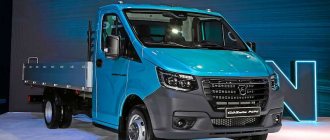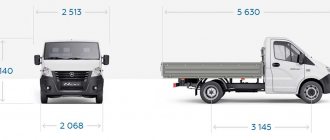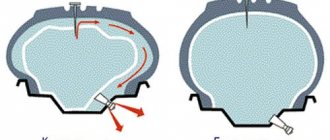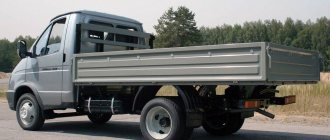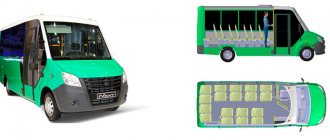Operating experience of GAZ 3302 "Gazelle"
The Gorky lorry has become an ideal option for transporting small consignments.
The prototype of the car is still considered to be the Ford Transit, but it is difficult to say whether this is actually true. But it is clear that the “Gazelle” is much inferior to the same “Transit” in quality. The first cars were extremely raw and fell apart literally before our eyes. We were told how one private owner paid $6,000 for a new Gazelle and over the next six (!) months invested the same amount in its repair! To find out whether the Gazelle has changed over the years, we went to a transport company that uses 7 vehicles produced in 2000-2001. Cabin.
In terms of its internal dimensions, the driver's cabin is satisfactory. The steering wheel and seat adjustments are quite reliable and allow you to sit quite comfortably in the driver's seat. But there are plenty of complaints. First, it's low-quality dashboard plastic that warps in the heat. The glove box lid, for example, loses its shape over time and bends in an arc. The second headache is the power windows. To raise/lower the window, the handle must be twisted several tens of turns. If you use the window regulator a hundred times a day (in summer, for example), the mechanism may fall apart in a month! A new mechanism for one door can cost up to 500 rubles. The hazard warning button sometimes falls apart due to worn out tendrils. It would seem that it’s a small thing and can be changed in five minutes. No matter how it is! The electrical connector falls under the panel, and in order to get it out and attach the button to it, you have to disassemble almost half of the dashboard. Go ahead. In winter, the central ventilation deflectors in the cabin have to be sealed with tape - otherwise cold air from the street freely penetrates into the cabin. The standard stove is too weak to deal with such drafts. The stove itself also has a problem - the pipes supplying liquid to the heating radiator are torn. Also, according to drivers, the cabin needs opening windows and a sunroof for better ventilation. In addition, the car clearly needs larger rear-view mirrors, a larger capacity windshield washer reservoir and more reliable external door handles. The current handles often break off, as they say, “at the root.” A darker and, if possible, harder door upholstery is also desirable, since the light fabric currently offered quickly becomes dirty and wiped out.
Engine.
The four vehicles in use are equipped with a 2.5-liter ZMZ-402 gasoline engine, which produces 90 hp on AI-80 gasoline, and 100 hp on 92-octane gasoline. In the city, a loaded car consumes up to 17 liters of “ninety-second” per 100 km. When using 80-grade gasoline, consumption increases by 1 -1.5 liters. Three cars are equipped with the Ulyanovsk UMZ-421 with a volume of 2.9 liters and a power of 90 hp. With it, a loaded Gazelle “eats” up to 22 liters of “eightieth” per 100 km in the city. Both engines are prone to overheating due to a weak cooling system. In order to somehow combat this, the transport company switched to more efficient three-row Turkish radiators. In addition, approximately every 10 - 15 thousand km you have to change the thermostats. Insufficiently rigid plastic adapters on the rubber pipes of the cooling system add to the problem. If coolant begins to leak in such connections, it is difficult to solve the problem by tightening the clamps - the tightened clamp simply crushes the unreinforced plastic adapter. If you overdo it and tighten the clamp too hard, the plastic will easily break. So a dilemma arises for the driver: if you don’t tighten the clamp, it’s bad, if you tighten it, it’s even worse. Cheap antifreeze caused a lot of problems. Its quality is such that it simply begins to “eat away” the cylinder block and the cylinder head! There are also comments about the 151st carburetor related to the need to constantly adjust it. A belt tensioner roller bearing is enough for about 30 thousand km. The total resource of the engine is about 100 thousand km. The chickens laugh!
Transmission.
On a 5-speed gearbox, there are difficulties with engaging 1st and 2nd gears, so you have to resort to shifting the throttle. The gearbox itself runs for about 50 thousand km, after which a bulkhead is needed. (By the way, when the Gazelle just started being produced, the cost of its new gearbox reached $1,500, while the price of the car itself was about $6,000! Now the price of the gearbox has dropped to 12,000 rubles). The gearbox also does not have the best sound insulation - the unit is separated from the passenger compartment only by a thin plastic panel. The rear axle gearbox does not cause problems yet, but when replacing it, instead of the original unit, it makes sense to install a higher-quality gearbox from Sobol. With proper driving, the clutch will be enough for 100 thousand km.
Electrical equipment.
Here comments are made regarding the weak contact group of the fuse box. The battery charging relay breaks down, and among the new “relays” in stores there are a lot of defective products. Diode bridges on the generator often fail. Due to weak sizing, the rear light blocks of the new, five-section design are falling apart. The old three-section lights are more reliable.
Suspension.
According to the assurances of the company's repairmen, the car's suspension is enough for 80 - 100 thousand km, provided that it is driven with a load of 1.2 tons. If you carry one and a half tons, then the suspension will be enough for 60 - 70 thousand km. Then the king pins, silent blocks, tie rod ends and wheel bearings are replaced. Sagging springs can be “refreshed” by replacing the main leaves, if there is no money to replace all the spring packages. It is interesting that a stabilizer bar can be installed on the rear axle, but the factory installs stabilizers on the Sobol and Barguzin models, and ignores the Gazelle. Although, it would seem, the Gazelle needs it more than necessary: after all, one and a half tons of cargo in the back rock the car like a boat in a storm. As a result, the company installs stabilizers on its own, shelling out about 2,000 rubles for a set. Other problems include cases where shock absorber brackets were torn off when driving over potholes.
The car is equipped with 16-inch tires and is offered by several manufacturers. The company praises Kirov and Nizhnekamsk tires. But products from Voronezh and Yaroslavl cannot withstand a full vehicle load and the wheel rim begins to cut the tire cord. You should also separately mark the space for the spare wheel. It is located between the frame and the body, but the wheel itself rests on two legs and is fixed by a third, which is attached to the rear cross member of the frame with a bolt. Absolutely “brilliant” system! The designers did not seem to think that the wheel could be “taken away” in broad daylight by simply bending this very fixing piece of iron. So, as usual, drivers figure it out themselves: some connect the wheel to a chain, others come up with more complex designs.
Brakes.
There are ventilated discs at the front and drums at the rear. With careful driving, the front pads will last up to 30 thousand km, and the rear ones up to 50 - 60 thousand km. The front brake discs are enough for a mileage of more than 100 thousand km. It’s interesting that cars initially have straight brake discs, but a new disc bought in a store may turn out to be crooked.
Steering.
The main problem here is one - there is no power steering, which would make the driver’s already harsh everyday life much easier. The tie rod ends, as already noted, are enough for 80-100 thousand km with a load of 1.2 tons. The steering shaft crosspieces “live” 30-40 thousand km.
Bottom line.
“A poor car for a poor country” - this phrase most accurately defines the essence of the Gazelle. The plant is in no hurry to bring the car to fruition. What for? They already buy it in such quantities that foreign cars are not even close. For the low price and primitive design, everyone forgives this machine. The question is, will GAZ go far with this approach to customers?
We thank Vladimir AMOSOV for his help in preparing the material
A new Gazelle or a used foreign car: which is more profitable?
Carriers building their own business often ask the question: “What is more profitable – a new GAZelle NEXT or a used foreign car? The answer to this is not as obvious as it might seem at first glance.
Alexander Trokhachev
Let's look at the pros and cons of both solutions from all sides, based on market realities and the experience of representatives of this profession. Here it is important to keep a cool mind and not be captured by stereotypes and unfounded illusions.
Let's start with the fact that the price of a new Gazelle and a used foreign car is not always the same - a Gazelle is usually more expensive. If a foreign used car is fresh, no more than three years old, in monetary terms it may be comparable to our truck. But a cheaper used car doesn’t necessarily mean it’s more profitable for private businesses. The purchase price may be more attractive. And how much does one need to spend on replacing the battery, a new set of tires, performing routine maintenance, instrumental diagnostics and eliminating minor (so far) faults - who has counted? All this may be needed soon after purchasing a used car.
1:0 in favor of the new GAZelle
Another important aspect is the method of purchase: with your own funds or borrowed funds? The ideal option is to buy with your own money (if you have any). A loan for a used car will only be issued at an extortionate interest rate. If you take a consumer loan, then the conditions here are even worse. Borrow from friends? Well, this: it is unknown how soon the investment will be returned and whether it will be returned at all. At the same time, special loan programs are always available for a new car, which are subsidized by the manufacturer, and it is easier to get such a loan secured by the car itself.
2:0 in favor of the new GAZelle
The times when domestic “one and a half” vehicles were catastrophically inferior in quality of materials and workmanship to foreign cars are a thing of the past. Today, the Nizhny Novgorod light-duty truck consists of a mass of imported components, starting with on-board electrical equipment elements and ending with the engine. This means that in terms of the reliability of these components, a domestic car will not be inferior to an imported one. At least that's what I want to believe. And foreign LCVs for many years, as a rule, are not European, but Russian-made. Simply put, despite the difference in brands and market value of the cars, these cars are very similar. But let's not rush to conclusions.
Practice shows that when used intensively as a delivery truck or minibus, domestic equipment is not particularly durable. In this sense, even the Ford Transit, Mercedes-Benz Sprinter and FIAT Ducato assembled in Russia look preferable. On the other hand, the modern Gazelle NEXT (and more recently the Gazelle NN) are provided with a factory warranty for a period of three years or a mileage of up to 200 thousand km. This is a solid reserve of peace of mind in case of breakdown, failure, failure of certain components and assemblies. A used foreign car over three years old does not have such a “cushion”. If something happens, you will have to repair it at your own expense.
3:0 in favor of the new GAZelle
A used foreign car, as a rule, has a worn-out tread, which means that the new Gazelle has an advantage in terms of mileage on the factory set. The bearer of the deer on the emblem without mileage has not yet been exposed to road salt and chemicals, moisture, sand and stones, therefore, it will not begin to rust soon. A used foreign car probably already has problems with the “red plague”. Removing rust and preventing it with anticorrosive agents will require additional costs, while a new lorry may not need such a measure soon. True, responses from Gazelle owners indicate that even modern anticorrosion protection does not save metal from corrosion. It's a draw. But the overall score so far:
4:1 in favor of the new GAZelle
"Gazelle", regardless of whether it is "Business" or "Next", loses its market value faster than a foreign car. And if a car is purchased for a period of operation of three to five years, then from the point of view of minimizing losses, a used foreign car is perhaps more attractive. Carriers say that the Gazelle is suitable for those who can and are accustomed to repairing equipment with their own hands. Foreign cars of the same class break down less often, sometimes less critically, and their service life is longer. At least, a strong “foreigner” will not crumble even after a run of 200-300 thousand km, which (according to reviews on forums) cannot be said about the “Gazelle”. There are especially many complaints about the chassis, which, when driving in our “directions,” requires periodic wheel alignment adjustments. But at the same time, suspension spare parts for a used foreign car will be two to three times more expensive than Gazelle ones. Again a draw, and the overall score:
5:2 in favor of the new GAZelle
Whatever the brand of a light-duty vehicle, sooner or later it will have to be repaired. The cost of consumables and spare parts for the Gazelle is, as a rule, one and a half to two times lower than the cost of analogues for foreign cars. Original GAZ parts can be purchased literally at every step, while for foreign cars they can only be purchased in specialized offline stores, dealership centers or the Internet. Maintenance of a domestic truck is three times cheaper than an imported classmate, you don’t have to wait long for spare parts, and you can fix it almost on your knees. But the cost of maintenance for a used foreign car in an unofficial service is almost the same as for the new Next.
6:2 in favor of the new GAZelle
From experience, Gazelle pays for itself faster, ideally within one and a half years, and then makes a profit. The payback period for a foreign car is at least two years, and this must be taken into account. After three years of operation, a new Gazelle loses about 22% of its value, while a used foreign car loses up to 25%, although, by and large, everything is individual. Plus, GAZelle is more liquid: a well-maintained example, even one that has traveled several hundred thousand km, can be quickly sold, but a foreign car with high mileage can “freeze.”
7:2 favor of the new GAZelle
Experienced carriers claim that fuel consumption on foreign cars is less, although for the most part this is a cliché. Modern Gazelles with imported engines are also not excessively gluttonous, and besides, there is always the opportunity to convert the car to natural gas. If we are talking about passenger transportation, then we need to take into account the driving comfort factor: it is higher on foreign cars. A number of metropolitan transport companies do not even consider applicants for a route with Gazelles as contractors, but in the regions the opposite is true. So it's a draw here. And the total score:
8:3 favor of the new GAZelle
At the same time, let’s not forget that selecting the same used van is not an easy task and involves a certain amount of risk. Going through the theft and maintenance databases of the foreign car you are buying and checking it with a paint tonometer for repainting after an accident is not enough. A used car may be seized due to the debts of the previous owner, and at the time of purchase everything could be clean. You also need to make sure that the car is in good condition and will not require additional repair costs in the near future. And here the brand and model are not of fundamental importance, be it Citroen Jumper, FIAT Ducato, Peugeot Partner, Volkswagen LT or their analogues.
9:3 in favor of the new GAZelle
Experts assure that the service life of domestic LCV is 200-250 thousand km, while that of imported analogues is 50-100 thousand km more. That is why when choosing a used “merchant” it is important to make sure that it is not in the state of a hunted horse. Of course, the driver’s saying “a good knock will come out on its own” has a right to life, but you can’t rely on chance. It makes more sense to involve an expert and try to determine the actual wear of the engine, the condition of the gearbox, fuel injection pump, electrical wiring and suspension. It's a good idea to do a thorough inspection of the radiator, air conditioning, spark plugs, etc. – all this will give an idea of the real condition of the car, and not just the mileage on the odometer. The buyer of a new car is freed from this “hemorrhoids”.
The result is devastating - 10:3 in favor of the new GAZelle
And yes, we do not advertise the products of the Gorky Automobile Plant - they are simply the most affordable in their class, both in price and service. This is confirmed by sales, where GAZelle is ahead of its competitors by a huge margin. In principle, any new car assembled from normal parts is a priori better than a used one - old Henry Ford spoke about this.
In general, the topic in the title divides the transport community into two irreconcilable camps. Supporters of “Gazelle” are ready to prove its advantages with foam at the mouth, but they are not a decree for fans of foreign cars: they have their own view of things. If you still weigh the pros and cons, the answer will be this. With low daily mileage, timely maintenance and careful operation for up to three years, the new Gazelle looks preferable to the old foreign car. However, after this it is recommended to sell it, since repair costs increase, and downtime due to breakdowns becomes more frequent. As you know, time is money, and no amount of downtime due to inexpensive repairs with cheap spare parts is worth it.
A used foreign car is more attractive when you get it technically sound and legally clean, with the prospect of profitable sale on the secondary market. The number of failures on used foreign cars is lower, the efficiency is better, and the mileage of parts is higher.
By the way, at one time, analysts from the Avtostat agency found out which light commercial vehicles of foreign brands are most profitable in Russian operating conditions. The six most popular models that are used for transportation in the Moscow and North-Western regions were subjected to research. The calculation took into account expenses for three years with an annual mileage of 40 thousand km. The costs of fuel, routine maintenance, insurance, transport tax and residual value on the secondary market were taken into account. So, the Ford Transit is recognized as the least expensive in terms of cost of ownership, with a cost per kilometer of 14 rubles. In second place is the Mercedes-Benz Sprinter Classic (15 rubles/km), in third place is the Citroen Jumper (15.9 rubles/km). Gazelle NEXT did not take part in the study, but according to GAZ Group specialists, its total cost of ownership is 20-30% lower than that of its European counterparts.
Of course, a lot depends on the nature of the transportation. For example, it makes no difference how to transport building materials from a warehouse or a store to customers. In passenger transport, on the contrary: a foreign car is often more attractive. In general, the benefit from using one or another car largely depends on the gasket between the steering wheel and the seat. If you treat the equipment adequately, it will serve for a long time, regularly bringing profit. So weigh all the pros and cons and boldly make a decision - some arguments will definitely outweigh you!
The editors recommend:
Why do piston rings stick and how to prevent it?
A traffic police officer searched my car: did he have the right to do so?
Russians may be left without foreign cars: Western automakers have stopped supplying cars to our country
A ship that was transporting cars to Russia was detained in France
Half of the car factories in Russia have closed
- LCV
- GAZelle Next
Discussion Cancel
From the author
While preparing articles about GAZ models, I am convinced once again: the quality of cars depends on the mood of the shift on the assembly line in Nizhny Novgorod. There are normal, quite working reviews, and there are clearly negative ones. There are also frankly paid reviews of GAZ cars. For example, I recently came across the phrase: “standing passengers are very comfortable in the GAZ 3302 Gazelle.” Question: where will they come from? Will the driver be seated in a non-tilted body?
There are enough such blunders, but (I note with some pleasure) most of the reviews are live. I advise you not to read reviews written with obvious spelling errors (to give credibility) by philologists from different faculties - they are not the best options to listen to. But reviews written expressively, with an understanding of the issue - this is valuable information.
Advantages of the car
Most car enthusiasts know that the GAZ-3302 (GAZelle) is one of the most unpretentious cars on the Russian market. Its maintenance requires a minimum of costs, but still do not think that this car does not require any care at all. Practice has shown that most of those who complain about problems with their car simply handled it carelessly.
In fact, the GAZ-3302 is an excellent combination of not the highest price and excellent consumer qualities, which many models from competing manufacturers cannot boast of. This car has an excellent suspension that can be easily modified. GAZelle is an incredibly versatile and maneuverable car that can drive on most types of road surfaces. Even dirt will not stop the GAZ-3302. The photo below can prove this.
Equipment, prices, lottery
GAZ 3302 is the very first GAZelle model, which launched the new family 20 years ago. The car is definitely popular, because everyone uses gazelles. GAZ 3302 was originally an on-board light-duty vehicle capable of efficiently transporting 1.5 tons of cargo; it is produced to this day in the GAZelle-business and GAZelle-NEXT families. The plant offers 20 main modifications. Additional equipment is the GAZ 3302 van (booths can be installed to order on a clean chassis). For the farmer version, a cabin with two rows of seats is installed on the basis of the same truck.
3 types of engine are offered: domestic gasoline UMZ-42146 (Euro 4), Camminiz diesel (Euro 4, diesel, with turbocharging and charge air cooler, 2.8 l, 120 “horses”), and UMZ-421467 “gas+” engine gasoline”, with a choice of gas equipment (LPG-propane/CNG-methane). Standard version (with a regular body) and extended version. You can choose any drive as standard; extended ones – only rear-wheel drive. The price of the new GAZ 3302 in basic configurations is 580-776 thousand rubles.
What do consumers say about new cars? They don't scold much. There are sores, but the car drives and brings a penny to the owner - that’s why they took it. The price is good. If there is no rain before 10,000 km, then you are lucky! In general (a lot has already been written on this topic), buying a GAZelle is like a lottery: either you buy a construction set, or a relatively normal car (forgive the sarcasm, but God probably distributes them depending on the degree of “sinfulness” of the soul). But outright defective GAZ on line 3302 does not put it on sale. If there are cases, they are isolated.
For cars older than 10 years: owners often complain about the lack of power (the 406 engine produces little) and carburetors. Fuel consumption indicators also suffer: instead of the promised 11-12 l/100 km, “veterans” consume from 15-16 liters per hundred; some GAZ 3302 owners manage to increase consumption to 20 l/100 km. There are not many complaints about new GAZelles, especially those with Cummins engines; in most cases, consumers are satisfied with the quality and actual parameters of the engines.
Old versions of the GAZ 3302 do not have a hydraulic booster - this is their main drawback. It is present on new ones, but it causes a number of complaints: for some owners, despite the factory’s assurances that the leaks have been eliminated, history repeats itself from year to year. The trial period for GIR is 5-10 thousand km. If it doesn’t break before this point, everything will be fine, luck with the components and assembly. If the hydraulic indicator leaks, then one gets the impression (in each such story) that the driver is punished by repairing the hydraulic indicator until the end of the period of ownership of this particular car.
Many owners of cars older than 5-7 years are complaining about the quality of the gearbox. The situation is the same as with the GIR: the owner, who ordered the repair of the gearbox once, is punished by it forever. There are described cases of not only repairs, but also permanent replacement of an entire gearbox, which do not give any economically justified result. In reviews of cars since 2011. Such complaints practically never occur.
Cost of new and used GAZ-3302
Depending on the version, the cost of GAZ-3302 varies. The standard modification in the basic version will cost 580,000 rubles. With additional settings, the price can increase to 780,000 rubles. Modifications with a Chrysler power plant cost 30,000-50,000 rubles more.
Used versions of the GAZ-3302 are offered in a wide range. The average cost of models produced in 1999 is 100,000 rubles, and those produced in 2007 are 230,000 rubles.
Renting a car will cost 1100-1200 rubles per hour.
Spare parts and service
First about spare parts. Everything suits the owners in terms of price, but the quality often lets us down. The popularity of the model played a standard marketing joke on it: everyone who is not too lazy produces spare parts for GAZelle. Here everyone has their own methods: to collect spare parts in buckets for less, or to find a normal supplier a little more expensive. Most owners are happy with both options.
Almost everyone is not satisfied with warranty service. The plant constantly declares its work and achievements in terms of service; consumers persistently publish reviews that the service is only a name. Owners of GAZelles (and not only) are not satisfied to a large extent with the negligent attitude of service workers towards their duties: they will replace a part, but in such a way that it is better to do it yourself. We are reluctant to service cars that are under warranty - you can’t make money on them, so they suck at it.
Body
The sides of the GAZ 3302 body are a weak point. On the first machines (which are still in operation) they have already been changed more than once. On cars even ten years old, the metal has been cooked more than once, melting like sugar in boiling water. On the latest samples (GAZ knows about the problem), the sides are additionally primed. How much this saves is unclear. The complaint in reviews is one of the most common.
The plant came close to the issues of corrosion protection 3 years ago. Today, according to the official website of the GAZ group, 47 parts of the body base are galvanized on both sides, surface phosphating and cathophoresis priming are used.
Driving style
The service life of the GAZ-3302 (GAZelle) car is significantly influenced by the driving style of a particular driver. If you drive your car carelessly, you can destroy it much faster than the famous “high-quality” Russian roads would. Because of this, you should be very careful when selecting drivers for your company, because their skills and careful handling of equipment are the key to the success of any business.
Facts about GAZ 3302 from the owners
• The doors of any old GAZelle can be opened with a screwdriver. • Old cars do not have comfortable enough seats, even for traveling around the region. • On a car over 10 years old, it is advisable to change all electrical wiring and lighting: the boards oxidize (sometimes earlier), the wires simply crumble into dust. • Many people also complain about weak frames in cars that are 5 years old. • Cars before 2007 have a weak heater. • Complaints about the radiator were found only once in reviews of the GAZ 3302.
• In many responses there are hints about the mysterious disappearance of technical fluids even with all the nuts and clamps tightened - mysticism, and that’s all! • Good luck in buying a GAZelle is a great thing! There are reviews in which the owners were afraid that the car would not last even 50 thousand, but now their mileage has already exceeded 300 thousand - and they won’t praise the car! • Since 2011, reviews of the car have been much warmer than earlier versions: the manufacturer has taken into account many previous shortcomings. Cars 2002-2007 attract the sharpest criticism.
Making changes to the body structure
Some GAZ-3302 owners install a very high booth (about four meters high) on their car. At the same time, the owner does not take into account that an even greater load will be placed on the car frame. In addition, the car’s center of gravity shifts, which means that the GAZelle will begin to roll significantly when cornering, and the aerodynamics will not change for the better. Such body modifications should only be carried out by the manufacturer. In general, every driver should know that making changes to the design is a violation of technical regulations, that is, it is unlikely that it will be possible to pass a technical inspection legally.
Refit me!
The main changes that the owners make to the design are extending the awning and strengthening the springs. All in order to carry more. These measures allow you to increase the payback of the car several times, but completely ruin the engine and chassis. Hence - a lot of repairs. Most drivers refuse to accept this fact: they have to drive and that’s it! And then they wonder why the main bearings in the rear part crunch and crumble.
There are stories about how GAZelles transported 3 tons of cargo. These machines pay for themselves very quickly, although for some reason the owners do not keep them for more than a year and send them “to the people” at the first opportunity. Although, with normal operation and timely maintenance, it is the best car in its class.
In old cars, the stove and interior are also subject to fine-tuning: the old GAZ 3302 heater is weak and in cold weather it is cold in the car. With a new cabin, after restyling in 2000, the car became warmer.
GAZelle overload
The first thing any GAZelle will certainly encounter when it gets into the garage of almost every Russian businessman is the daily overload of the car. Enterprising people try to squeeze literally all the juice out of the poor GAZ-3302, forgetting that its frame was designed by engineers for only one and a half tons of carrying capacity (of course, there is a small reserve).
By the way, the carrying capacity of a GAZelle van is even less, since the all-metal body also has a considerable weight. Many entrepreneurs do not pay attention to this, starting to load their car to the maximum, after which many complaints appear about problems with the car. In addition to the frame, both the transmission and the engine suffer.
The GAZ-3302 can handle an overload of no more than five hundred kilograms without any special difficulties, and only if this happens once or twice. But if you constantly overload the car, problems will begin.
First, the GAZelle springs will begin to “give up.” Of course, you can strengthen them, but this is also a double-edged sword: the springs will undoubtedly support a much larger load, but the car will significantly lose its smoothness. In addition, even the smallest bumps on the road will lead to the strongest jumps of the car. If, on top of everything else, the GAZ-3302 is driven overloaded on bad roads, then the frame of the car may not be able to withstand it. And this can end not only in the loss of time and money on repairs.
There was metal - and there is no metal: we buy GAZelle 2705 for 200 thousand
Today's hero is not an elderly “premium for five hundred” and is far from a mass public sector employee. However, everyone knows this car, so we couldn’t ignore this bestseller of all time.
Having appeared back in 1994, GAZelle saved the plant in Nizhny Novgorod. It’s not hard to guess what would have happened to GAZ if this commercial vehicle had not appeared in its lineup. And although the quality of the cars of the first years of production became a joke, it was quickly appreciated in the business community. After all, there were still 10 years left before competitors with a similar price appeared, and the business boom already required an inexpensive light-duty truck.
A little later, all-metal cargo and passenger versions appeared, and the word “gazelle” itself eventually became a household word. Often, any minibus is called a “gazelle”, be it a Mercedes, Ford or Iveco.
Now on the secondary market you can buy it for pennies. And there are explanations for this. Shall we look at them?
Gazelle: history of creation and weak points of the truck
The most popular truck in Russia is called “Gazelle”, they literally filled the roads. And for those who are directly involved in light-duty cargo transportation, this is a whole world.
The appearance of the Gazelle family of trucks and minibuses was the most significant event in the history of the domestic automotive industry in the post-Soviet period. Cars of this brand spread with amazing speed. A new formation of drivers has emerged, which is sometimes called “gazelatnik”. Some of them used to drive “real” trucks. Others have never driven anything larger than a Zhiguli before this truck; there are also young people for whom a Gazelle is the first car in their life.
And the truck itself, for all its advantages, which brought it enormous popularity, is a typical product of the Russian automobile industry of the era of market reforms, and for this reason it had design flaws. There were also complaints about the quality of workmanship. The topic of technical malfunctions of gazelles and the torment of eliminating them is inexhaustible and, as the experience of preparing this article has shown, it is loved by “gazeleers.” But first we need to remember the background and circumstances of the birth of this family.
The shortage of light-duty trucks in the USSR was acutely felt at the turn of the 50s and 60s. Even then, GAZ had a project for a one and a half ton GAZ-56 truck with a Volga GAZ-21 engine. But the country's leadership relied on UAZs, in particular, the UAZ-451, the all-wheel drive version of the “loaf” or “tadpole”. These machines worked in the USSR for a long time and honestly performed their duties. But, firstly, the volume of their production was still insufficient, and secondly, over the years, the need for a car that would occupy a place between the UAZ and the GAZ-52 in size and load-carrying capacity grew.
In the 80s, they tried to plug this hole in the type by importing into the USSR Avia trucks and vans, a Czechoslovak licensed version of the French Saviem and Renault cars. At the same time, two attempts were made to create a domestic car of the same class. The first was “project 3772” of the Ulyanovsk plant for an enterprise that was never built in the Azerbaijani Kirovobad. The second car, BAZ-3778, as can be seen from the index, was to be produced by the Bryansk Automobile Plant, famous for its rocket tractors. The English body shop IAD participated in its development. Let us note that in both cases, considerable work was carried out by NAMI specialists, and the matter could not have happened without the participation of the Gorky Automobile Plant. Moreover, in those days everyone worked for the state.
Economic turmoil at the turn of the 80s and 90s buried both projects. Today, evil tongues sometimes say that Gazelle buried them, but the truth is that neither one nor the other plant was able to close the gap that had formed in the market. And in those years, GAZ’s production volume of traditional medium-duty vehicles fell.
Using the experience gained from participating in the development and testing of the Ulyanovsk-Kirovobad and Bryansk machines, Gorky designers created their own alternative project in a very short time. Despite everything, there was no real experience in the production and operation of such a car in Russia: not even a family of original cars was born, but a new class. According to professional designers who worked at our car factories for many years, it was the rush that became one of the reasons that the Gazelle was born with many shortcomings. But what was the alternative - spending years testing and fine-tuning? So, you may not even put the new product on the assembly line at all, but the machine was needed yesterday. GAZ made the main compromise, deciding to eliminate shortcomings in the production process, and did not lose.
Weaknesses of Gazelles
For the owner of a passenger car, one of the most important questions is how quickly the body will rust through. It would seem that this is easier for a truck: with a frame design, it can work even with a rotten cab. Still, the durability of the cabin is an interesting indicator for those who honestly undergo technical inspection or who are concerned about how quickly their car will lose its value. Can the cabin of the onboard “Gazelle” and the body of the “carriage” be called a durable product? What is the quality of factory painting and anti-corrosion treatment?
Why do many cars have holes in their doors, sills, wheel arches, and hood covers? How do design features affect the rate of corrosion spread: the presence of hidden cavities, drainage, ventilation? Why does it happen that wooden decking on the bottom of a side platform lasts longer than steel sides? And finally, what has changed with the advent of a new painting line at GAZ? All these questions, which seem to have obvious answers, are far from being as simple as they seem, and deserve a separate discussion.
In addition to rust, the car body and cargo compartment have another enemy - fatigue damage. After several years of intensive use, characteristic cracks appear in the Gazelle’s cabin. The body of a van and minibus also loses its rigidity, for example, the geometry of the rear double door opening is disrupted. The frame cross members also burst. Whether such a car can be restored, and in what case it is on the right path to write-off, is also a separate discussion.
The Gorky Automobile Plant has always unified engines as much as possible, and if possible, then other systems in its truck and passenger models. In catalogs of past years, entire tables were printed on the interchangeability of spare parts for truck “lawns” with “Pobeda”, ZIM, “Volga” and “Chaika”. The small-tonnage vehicle was created focusing on Volga units. Its ancient engine, now called ZMZ-402, became one of those compromises that gave life to the lorry. In 1994, presenting the first “Gazelle” to the public, the factory workers said that the main engine for it would be the ZMZ-406Yu, which was not yet produced in the required quantities, and the “402” was used “temporarily”. This focus on a “bright future” gave rise to the already mentioned problem of overheating.
As the developers said, the Gazelle’s cooling system was designed for the more heat-intensive ZMZ-406. It was assumed that there would be no problems with cooling the 402. But the new engine had a smaller frontal area, and the wide old engine blocked the radiator at the rear, while in front there was a solid bumper, characteristic of the first releases - ventilation windows appeared on it only later. And the radiator simply had nothing to give off the accumulated heat. By making those same holes in the bumper, improving the fan and improving the circulation of coolant, the plant was able to cope with overheating. But the problem of engine quality remained.
It was in the Soviet Union that the Zavolzhsky Plant produced GAZ-24 engines, which, with proper care, lasted from 180 to 250 thousand km without major repairs. By the time the first Gazelle was released, the country was falling into new economic relations. And as repairmen testify, it was considered lucky if a Volga engine produced after 1991 lasted at least 100 thousand without a rebuild. For the Gazelle, the operating conditions of the same engine are much more difficult. When ZMZ launched the modern, and therefore quite complex ZMZ-406, into production, its first batches became an indicator of all the design and technological shortcomings. Naturally, this hurt the pockets of car owners, because spare parts for the 406 engine are much more expensive than for the 402. Over time, of course, it turned out that ZMZ-406 was not so scary.
The gearbox, rear axle gearbox, and electrical equipment also work for a long time and honestly in some cars, while in others they are a source of headaches. Find a used truck
Review of GAZelle Next 2022
Finally, let us emphasize once again that the quality of manufacturing and design work of the Gazelle is not something out of the ordinary. This is a completely normal level. Moreover, this is not the worst option: Zilov’s “Bull” has a whole bunch of much less pleasant congenital defects. And despite everything, “Gazelles” are selling like hot cakes. After all, an inexpensive truck or minibus is also very profitable. Its task is to earn money, feed the owner and driver, and quickly pay for itself and the costs of its operation. And “Gazelles” honestly feed, if not millions, then hundreds and hundreds of thousands of people.
vote
Article rating
